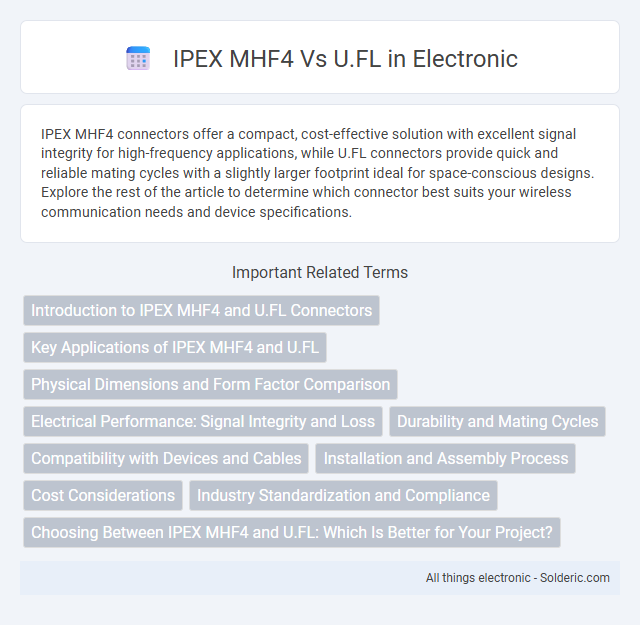IPEX MHF4 connectors offer a compact, cost-effective solution with excellent signal integrity for high-frequency applications, while U.FL connectors provide quick and reliable mating cycles with a slightly larger footprint ideal for space-conscious designs. Explore the rest of the article to determine which connector best suits your wireless communication needs and device specifications.
Comparison Table
| Feature | IPEX MHF4 | U.FL |
|---|---|---|
| Connector Type | Micro Coaxial RF Connector | Micro Coaxial RF Connector |
| Size | 1.25mm Height | 2.5mm Height |
| Frequency Range | Up to 6 GHz | Up to 6 GHz |
| Impedance | 50 Ohms | 50 Ohms |
| Mating Cycles | Up to 30 | Up to 30 |
| Common Usage | Modern IoT and Wi-Fi Modules | Legacy Wi-Fi and Cellular Modules |
| Manufacturer | IPX Consortium (Murata, Hirose) | Hirose Electric Group (U.FL by Hirose) |
| Application | Finer pitch, smaller space requirements | Widely used, slightly larger footprint |
Introduction to IPEX MHF4 and U.FL Connectors
IPEX MHF4 and U.FL connectors are widely used in RF applications for their compact size and reliable performance. IPEX MHF4 offers a smaller footprint and higher frequency range up to 6 GHz, making it suitable for modern wireless devices, while U.FL connectors support frequencies up to 3 GHz and are commonly chosen for Wi-Fi and Bluetooth modules. Your choice between IPEX MHF4 and U.FL will depend on space constraints and frequency requirements in your electronic designs.
Key Applications of IPEX MHF4 and U.FL
IPEX MHF4 connectors are primarily used in compact wireless devices such as smartphones, tablets, and IoT sensors where high-frequency signal integrity and minimal space usage are critical. U.FL connectors find their key applications in Wi-Fi modules, GPS devices, and embedded systems requiring reliable RF connections with easy mating and unmating capabilities. Both connector types support antenna interfacing but are chosen based on design constraints and performance requirements specific to modern wireless communication hardware.
Physical Dimensions and Form Factor Comparison
IPEX MHF4 connectors are significantly smaller than U.FL connectors, measuring approximately 2.0 mm by 2.0 mm compared to U.FL's 2.5 mm by 2.5 mm footprint, making them ideal for ultra-compact wireless devices. The lower profile of MHF4, with a height of about 0.9 mm versus U.FL's 1.4 mm, enhances your design flexibility in tight spaces and reduces overall device thickness. This compact form factor of MHF4 supports advanced miniaturization trends in IoT and mobile applications where saving space is critical.
Electrical Performance: Signal Integrity and Loss
IPEX MHF4 connectors offer superior electrical performance with lower insertion loss and enhanced signal integrity compared to U.FL connectors, supporting high-frequency applications up to 6 GHz efficiently. Their optimized design minimizes impedance mismatch and crosstalk, ensuring cleaner signal transmission in dense electronic environments. If you require reliable RF connections with minimal signal degradation, IPEX MHF4 is a preferred choice for maintaining optimal electrical performance.
Durability and Mating Cycles
IPEX MHF4 connectors offer superior durability with a typical mating cycle rating of around 30 to 50 cycles, making them well-suited for applications requiring frequent reconnections. U.FL connectors generally support fewer mating cycles, approximately 30, and are more prone to wear and damage under repeated use. The robust design of IPEX MHF4 enhances reliability in high-cycle environments compared to the more delicate U.FL connectors.
Compatibility with Devices and Cables
IPEX MHF4 connectors offer compatibility primarily with compact wireless modules and high-frequency cables used in modern smartphones and IoT devices, supporting frequencies up to 6 GHz. U.FL connectors are widely compatible with various RF cables and modules across numerous consumer electronics, favored for their standardized interface in Wi-Fi, Bluetooth, and GPS applications. When selecting between IPEX MHF4 and U.FL, device manufacturers must consider the connector's footprint, cable flexibility, and frequency range to ensure optimal connectivity and performance.
Installation and Assembly Process
IPEX MHF4 connectors offer a streamlined installation process with a push-on mechanism that reduces the need for specialized tools, making assembly quicker and more efficient compared to U.FL connectors. U.FL connectors require careful alignment and precise engagement, often necessitating delicate hand assembly or specialized equipment to avoid damage. The robust mechanical design of IPEX MHF4 enhances durability during repeated mating cycles, improving long-term reliability in high-density electronic applications.
Cost Considerations
IPEX MHF4 connectors generally offer a lower cost alternative compared to U.FL connectors, making them attractive for budget-sensitive projects. Their compact size and reliable performance reduce the need for costly rework or replacements in high-density applications. You can optimize your production expenses by selecting IPEX MHF4 when balancing quality and affordability is essential.
Industry Standardization and Compliance
IPEX MHF4 connectors comply with industry standards such as IEC 61169, ensuring reliable performance in high-frequency applications, while U.FL connectors conform to IPX and IEC 61169 standards, widely recognized in mobile and wireless communications. Both connector types meet stringent regulatory requirements for electromagnetic compatibility (EMC) and signal integrity, supporting your device's certification processes. Choosing IPEX MHF4 can offer enhanced durability and consistent compliance across advanced IoT and 5G modules compared to standard U.FL connectors.
Choosing Between IPEX MHF4 and U.FL: Which Is Better for Your Project?
IPEX MHF4 connectors offer superior signal integrity and higher frequency performance up to 6 GHz, making them ideal for advanced wireless applications requiring minimal signal loss. U.FL connectors, while compact and cost-effective, typically support lower frequencies up to 3 GHz and may exhibit higher insertion loss. Selecting IPEX MHF4 is preferable for projects demanding robust, high-frequency RF connections, whereas U.FL suits cost-sensitive designs with moderate performance requirements.
IPEX MHF4 vs U.FL Infographic

 solderic.com
solderic.com